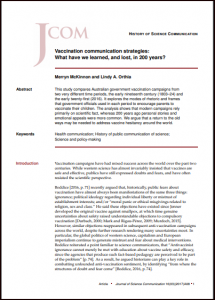Vaccination Communication Strategies: What Have We Learned, and Lost, in 200 Years?
This study compares Australian government vaccination campaigns from two very different time periods, the early nineteenth century (1803–24) and the early twenty-first (2016).
It explores the modes of rhetoric and frames that government officials used in each period to encourage parents to vaccinate their children. The analysis shows that modern campaigns rely primarily on scientific fact, whereas 200 years ago personal stories and emotional appeals were more common. The authors argue that a return to the old ways may be needed to address vaccine hesitancy around the world.
Last modified: December 30, 2020
Language: English

